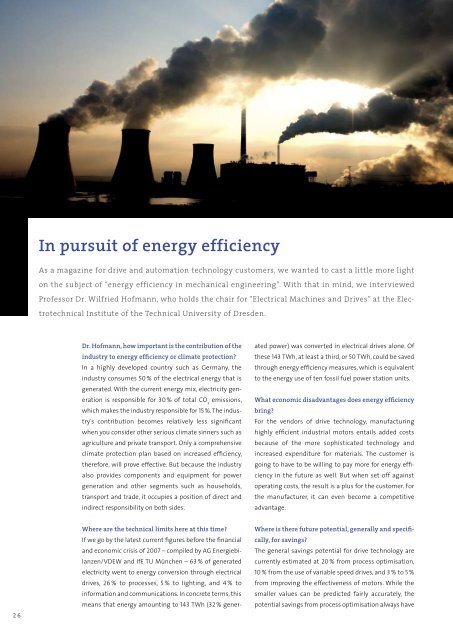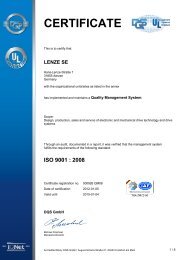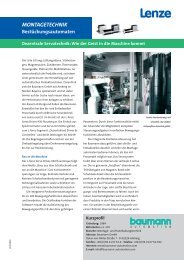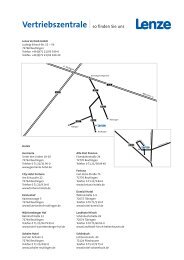Lenze's new international sales structure
Lenze's new international sales structure
Lenze's new international sales structure
You also want an ePaper? Increase the reach of your titles
YUMPU automatically turns print PDFs into web optimized ePapers that Google loves.
26<br />
In pursuit of energy efficiency<br />
As a magazine for drive and automation technology customers, we wanted to cast a little more light<br />
on the subject of “energy efficiency in mechanical engineering”. With that in mind, we interviewed<br />
Professor Dr. Wilfried Hofmann, who holds the chair for “Electrical Machines and Drives” at the Elec-<br />
trotechnical Institute of the Technical University of Dresden.<br />
Dr. Hofmann, how important is the contribution of the<br />
industry to energy efficiency or climate protection?<br />
In a highly developed country such as Germany, the<br />
industry consumes 50 % of the electrical energy that is<br />
generated. With the current energy mix, electricity gen-<br />
eration is responsible for 30 % of total CO 2 emissions,<br />
which makes the industry responsible for 15 %. The indus-<br />
try’s contribution becomes relatively less significant<br />
when you consider other serious climate sinners such as<br />
agriculture and private transport. Only a comprehensive<br />
climate protection plan based on increased efficiency,<br />
therefore, will prove effective. But because the industry<br />
also provides components and equipment for power<br />
generation and other segments such as households,<br />
transport and trade, it occupies a position of direct and<br />
indirect responsibility on both sides.<br />
Where are the technical limits here at this time?<br />
If we go by the latest current figures before the financial<br />
and economic crisis of 2007 – compiled by AG Energiebilanzen/VDEW<br />
and IfE TU München – 63 % of generated<br />
electricity went to energy conversion through electrical<br />
drives, 26 % to processes, 5 % to lighting, and 4 % to<br />
information and communications. In concrete terms, this<br />
means that energy amounting to 143 TWh (32 % gener-<br />
ated power) was converted in electrical drives alone. Of<br />
these 143 TWh, at least a third, or 50 TWh, could be saved<br />
through energy efficiency measures, which is equivalent<br />
to the energy use of ten fossil fuel power station units.<br />
What economic disadvantages does energy efficiency<br />
bring?<br />
For the vendors of drive technology, manufacturing<br />
highly efficient industrial motors entails added costs<br />
because of the more sophisticated technology and<br />
increased expenditure for materials. The customer is<br />
going to have to be willing to pay more for energy efficiency<br />
in the future as well. But when set off against<br />
operating costs, the result is a plus for the customer. For<br />
the manufacturer, it can even become a competitive<br />
advantage.<br />
Where is there future potential, generally and specifically,<br />
for savings?<br />
The general savings potential for drive technology are<br />
currently estimated at 20 % from process optimisation,<br />
10 % from the use of variable speed drives, and 3 % to 5 %<br />
from improving the effectiveness of motors. While the<br />
smaller values can be predicted fairly accurately, the<br />
potential savings from process optimisation always have












